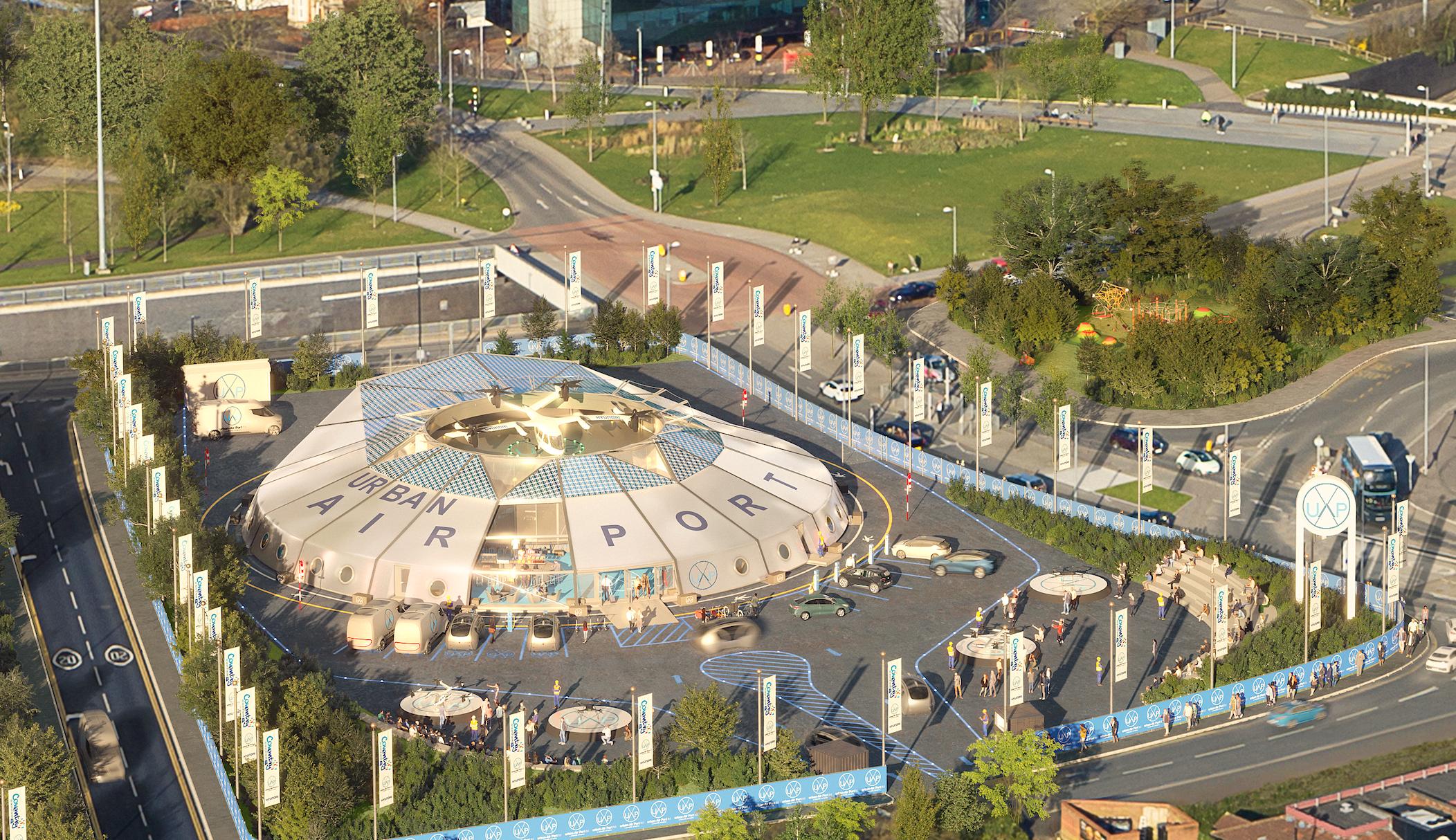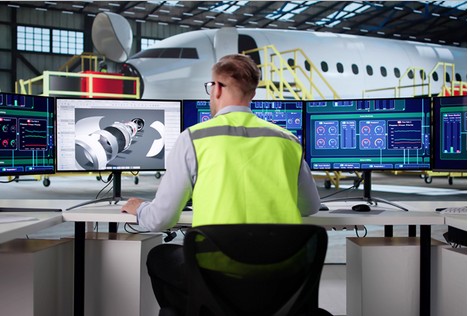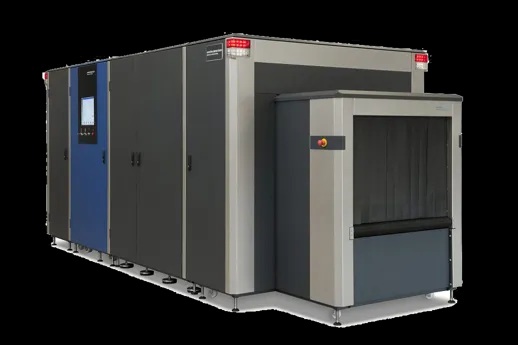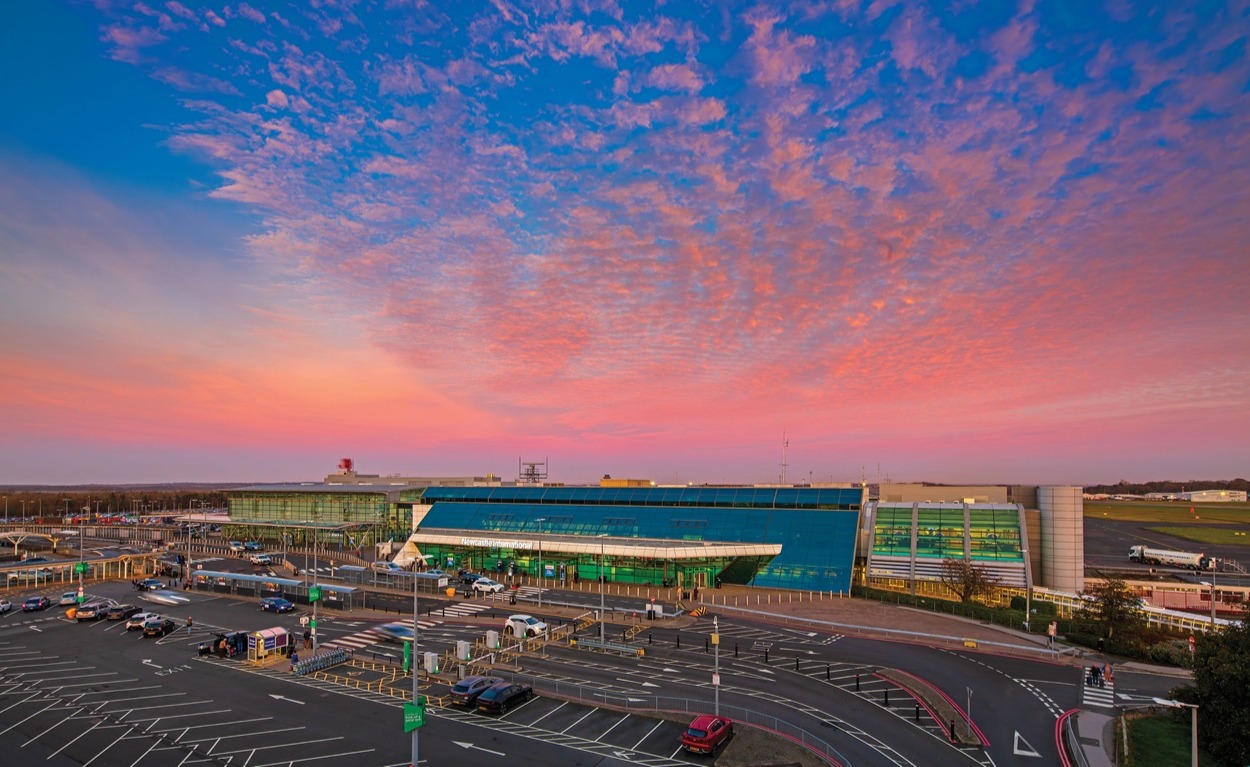UK Government backs Air Architecture for air taxis and drones

Above:
Visual representation Air-One in central Coventry.
Image Copyright © Urban-Air Port Ltd. All Rights Reserved.
These ‘air roads’ will enable people and cargo to travel by manned and unmanned electric vertical take-off and landing (eVTOL) aircraft. This world-first infrastructure programme, being demonstrated in Coventry later this year, is supported by the UK government as a significant step towards unlocking a future of clean urban air mobility for the UK and will provide a model for other countries to follow.
The Rt Hon Kwasi Kwarteng, Secretary of State for the Department of Business, Energy and Industrial Strategy, said: “Cleaner, inter-city flight technology is vital not only to reducing emissions but to better connecting remote communities, from small towns in the UK to isolated settlements all around the world. As we build back greener from the pandemic, initiatives like the government-backed Air-One project will help us develop the infrastructure needed to make our dreams of flying taxis a reality.”
The Government is supporting the development of urban air mobility to provide improved zero-carbon transport connectivity across the UK and reap the benefits from exporting these technologies to support this rapidly advancing global sector.
The global VTOL and drone market is estimated to be up to $2.9trn (£2.17trn) by 2040, according to Morgan Stanley.[i] In the US, NASA predicts urban air mobility could be worth up to $500bn (£375bn) in the near-term. These eVTOLs and drones could enable doctors or medicine to get to patients in record time, urgent deliveries to arrive quickly without causing congestion or pollution and travellers and packages to reach remote communities that don’t have reliable road or rail.
However, NASA estimates that more than 70% of the potential urban air mobility market value is dependent on infrastructure[iii] – this value is what Urban-Air Port is working to unlock. The company develops scalable, zero emission infrastructure for high frequency air mobility. Its Air-One project is a world-first hub for future air taxis, drones and ground-based electric transport, such as cars, e-bikes and e-scooters, which will open in central Coventry later this year.
The urban air mobility market is growing fast. The first eVTOLs are expected to be commercialised in the next three to five years. Hyundai, a key partner of Urban-Air Port, is one of several companies developing an eVTOL passenger vehicle. Hyundai’s will be commercialised by 2028. Joby Aviation, the US-based aerospace start-up, plans to launch a commercial air taxi service in 2024. In April, UPS, the global logistics giant, announced a deal to purchase 150 eVTOL vehicles, for delivery in 2024, to cut delivery times and access smaller markets, demonstrating the growing maturity of the sector.
The challenge now is to design the Air Architecture that allows these passenger vehicles to fly within and between cities and towns and to manage the thousands of delivery drones anticipated in the future, with Amazon already planning to launch a UK drone delivery service.
Ricky Sandhu, Founder of Urban-Air Port, said: “Our global transport systems are broken. Inner-city transport is congested, inefficient and polluted. In remote locations, it is either non-existent or over-priced, leaving many isolated and increasing economic disparity. But to fix this, we still look to siloed and ancient road and rail infrastructure.
“New innovations mean we can now reimagine transport to perfectly meet the needs of people and provide a cohesive, sustainable and reliable experience. Our Air Architecture can unlock clean and beautiful cities and connect the world in new ways – in the air and on the ground – bringing economic prosperity, cutting emissions and improving quality of life. This is a real British innovation success story – the UK can lead the world in accelerating this transport revolution.”
To create ‘air roads’ in which drones and eVTOLs will fly, Urban-Air Port has formed a memorandum of understanding with fellow British innovators Altitude Angel and Safeguard Vertiports. Altitude Angel has developed an intuitive, cost-effective platform to digitally support the local Urban-Air Port air traffic zone, enabling it to enhance and provide unified traffic management (UTM) Services. Safeguard Vertiports will develop a certification programme that will meet Civil Aviation Authority (CAA) regulations for safe operational turnarounds. The partners will work together to design, develop and demonstrate operational Air Architecture at the Urban-Air Port Air-One site later this year.
Altitude Angel provides the world’s leading UTM platform which enables unmanned aerial vehicles (UAVs) and manned eVTOL aviation, to fly between locations safely and securely. Urban-Air Port is developing an MoU with the CAA and offering support alongside Safeguard Vertiports, a CAA registered member, to define and develop the certification process for future UTM Air Architecture and Urban-Air Port operational requirements.
Richard Ellis, Chief Business Officer at Altitude Angel, said: “We are proud to be part of Air Architecture. By enabling eVTOL operators to safely transit through 'air roads' and integrate their operations into and around these urban airports, we will unlock the future potential of the national airspace infrastructure. Our platform will allow all users of the sky, from air-taxis and drone operators to general aviation and emergency service helicopters to share the airspace safely and securely.”
Chris Wood, Operations Manager at Safeguard Vertiports, said: “We are proud to be part of this developing transport infrastructure, providing critical analysis and support for the development of certifications and standards that will ensure the safe design and use of the platforms in Air Architecture.”
Air roads: a new Air Architecture
Similar to existing air corridors for commercial aircraft, air roads will be approved and regulated routes for future eVTOLs that will enable safe and efficient travel between Urban-Air Port hubs and other sites. In the initial phase, each corridor will provide segregated airspace at defined altitudes for individual manned and unmanned eVTOLs. Similar to traditional air traffic control, the process will initially be managed by people. As the systems mature, traffic monitoring will be conducted by intelligent autonomous systems and supervised by people.
The air roads will initially be separate from existing aircraft corridors, operating at a much lower altitude when unmanned. They will be created between strategic locations, away from buildings and roads. Once the safety and environmental benefits are demonstrated, the airspace will become increasingly unified and will gradually expand to more locations to meet rising demand.
Altitude Angel’s award-winning UTM platform enables manned and unmanned aircraft to be tracked, monitored, communicated with and controlled in unsegregated airspace in real-time. The company has already launched the world’s first commercial drone ‘test corridor’ in open and unrestricted airspace in the Thames Valley, west of London.
Case study: Delivering vaccines in record time
Urban-Air Port has also partnered with SkyFarer, the drone logistics operations and software company, and Coventry University, to demonstrate medical drone deliveries on the Air Architecture. The project will take place at the Air-One site in Coventry later this year. The project partners will demonstrate the technologies that could fly vaccines or medicines to healthcare professionals and patients in record time.
Elliot Parnham, Founder and CEO at SkyFarer, said: “Healthcare is a sector where drones can make a significant impact. Medical drones are an environmentally-friendly, fast and intelligent way of getting the necessary supplies to those that need it most. Building the necessary Air Architecture™ is a significant step towards cutting wait times and improving access to vital vaccines and medicines.”
Urban-Air Port: the transport hubs of the future
Urban-Air Port will provide the transport hubs of the future, connecting air, road and rail to improve connectivity, reduce congestion, cut pollution and help achieve zero carbon. The company recently partnered with a global EV charging leader to provide chargers at Air-One powered by clean hydrogen fuel cells.
The eVTOL air taxis and logistics drones have highly accurate vertical take-off and landing capabilities so do not need any runways or large landing areas, allowing Urban-Air Port sites to be positioned in the areas of greatest demand and close to connecting infrastructure such as rail hubs. eVTOL aircraft are also up to 100 times quieter than conventional aircraft.
The Urban Air Mobility Division of Hyundai Motor Group has chosen Urban-Air Port as its priority infrastructure partner to support the global growth of this new sector. In January 2021, Urban-Air Port was selected as a winner of the UK government’s Future Flight Challenge to develop aviation infrastructure, systems and architecture that enable the next generation of electric and autonomous air vehicles.
Urban-Air Port plans to develop more than 200 sites around the world in the next five years to meet global demand. Having secured funding for Air-One, Urban-Air Port is now in advanced discussions with investors to support its rapid commercialisation and global growth.
Robert Courts, Parliamentary Under-Secretary at the Department for Transport, said: “The UK continues to pave the way when it comes to the future of transport and this fantastic programme yet again places us at the forefront of improved zero-carbon connectivity.
“As we build back better, I’m delighted to support the Future Flight Challenge, which will explore innovative and greener ways to fly by developing ground-breaking electric and autonomous technology, propelling us further towards our net-zero goals.”












